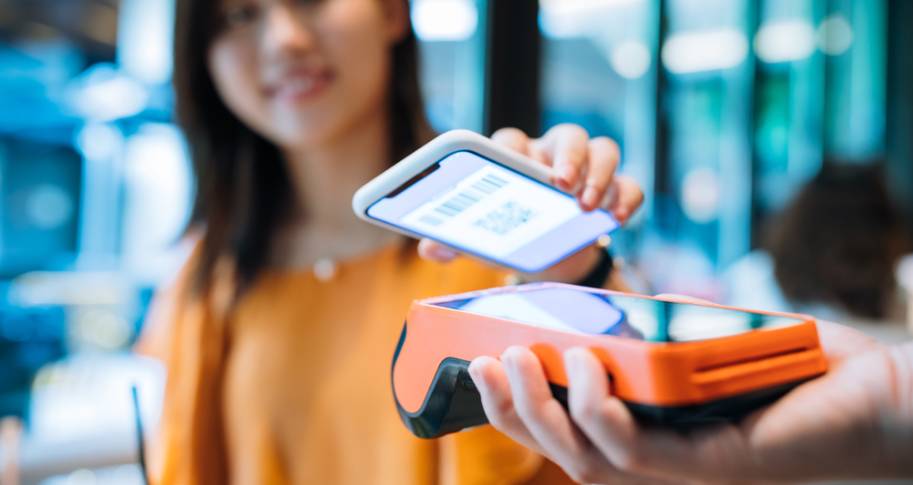Petty Cybercrime: How Modern Store Checkout Condones Shoplifting

July 17, 2020 | By Michael Adkison
Researcher: John A. Aloysius and Viswanath Venkatesh
In fall 2018, Walmart announced that it would launch a nationwide mobile checkout program, just in time for Black Friday shoppers to skip the lines.
The retail giant would arm its employees with a mobile device that could check out customers right in the middle of a store. “The new service, called Check Out with Me,” Business Insider wrote at the time, “is designed to help customers avoid one of the biggest frustrations with shopping in stores over the holidays: busy checkout lines.”
But that service was the second generation of a mobile-checkout wave; before Check Out with Me, there was Scan & Go, an app that allowed customers to scan products as they shopped and check out entirely on their own. That program was abandoned in 2018, just before Check Out with Me. The reason, according to a former Walmart executive, was numerous reports of theft.
“You think that the theft is bad on self-checkouts?” the Walmart executive, Joel Larson, said in 2019. “Wait until you try Scan & Go, where nobody is watching the customers out in the aisles.”
Does “skipping the line” and using modern technology to shop increase instances of shoplifting?
University of Arkansas professors John A. Aloysius and Viswanath Venkatesh have been studying the use of mobile technologies in shopping contexts for several years now. In their 2019 article “Shoplifting in mobile checkout settings: cybercrime in retail stores,” coauthored with a Ph.D. student, Ankur Arora, they analyze mobile checkout theft.
Mobile checkout seems to be the future of retail, but it certainly poses risks when it comes to theft. “90 percent of retail crime was due to shoplifting by customers,” the researchers say, and “the evolution of technology has brought new ways of conducting cybercrime.” And amid the COVID-19 crisis, shoppers are turning to mobile apps and delivery services from stores like Walmart and Amazon en masse to prevent the spread of disease.
The researchers say mobile checkout is a sort of like a gateway drug to shoplifting; it allows prospective shoplifters, a demographic not evaluated prior to this article, the ease and simplicity of theft right at their fingertips.
It Takes a Thief
An age-old philosophical question is whether or not every human is capable of committing a crime; while this article doesn’t seek to answer that question, it does contribute to existing literature on criminology by the recognizing the ease of shoplifting that modern technology permits. Shoplifting is defined by the researchers as an “act of misbehavior [by customers] of stealing merchandise from stores either for fun, money or to satisfy their psychological impulses.”
But the researchers say the world we live in is not so black-and-white between shoplifters and non-shoplifters. Instead, consumers can be either experienced shoplifters, prospective shoplifters or honest customers.
Experienced shoplifters, naturally, are individuals who have shoplifted before. At the other end of the spectrum are honest customers, those who believe shoplifting is wrong and would never commit the act. And in-between are prospective shoplifters: individuals who “have not previously shoplifted, but have the desire to shoplift and could commit shoplifting given conducive retail store settings.”
Maybe the timing was wrong, or the risks were too great; whatever the reason, these prospective shoplifters have yet to commit the act. But with the ease of shoplifting via mobile shopping devices, the researchers say shoplifting rates may rise, as the crime becomes easier to commit than ever before.
So, how does mobile shopping work, and how is it conducive to shoplifting? The researchers define three different settings, or “environments to which a person is exposed,” with regard to mobile shopping:
- Smartphone checkout settings—the use of a smartphone to scan products by opening an app on the phone and making the payment through a mobile wallet [E.g., Walmart’s Scan & Go app].
- Store-provided mobile device checkout settings—the use of a store-provided mobile device by a customer to scan products in the basket and the basket is assigned an electronic ID. The customer uses a self-service lane and the basket ID is used for payment.
- Employee-assisted mobile checkout settings—a store employee is equipped with a mobile device to scan the products in a customer’s basket and uses a mobile credit card machine to accept payment on the shop floor [E.g., Walmart’s Check Out with Me program].
While the technology makes shoplifting easier, the crime itself remains the same. The only change is how someone shoplifts.
Now, instead of quickly sticking those razors in your pocket when the clerk isn’t looking, you just have to “miss” the barcode when scanning the product into your smartphone.
Victimless Cybercrime
The researchers conducted a study on how the modern shopping experience, specifically mobile shopping, permits shoplifting. Citing a massive survey, focus groups, and prior research on technology and criminology, the researchers present hypotheses that “shoplifters, both experienced and prospective, are more likely to derive pleasure from the entertainment in autonomous mobile checkout settings, as they pretend to scan the items and are able to carry out more items from the store than for which they actually pay.” They also postulate that the ease of use for the technology and peer pressure will encourage individuals to shoplift.
The sample of nearly 500 participants was divided into three groups: “146 experienced shoplifters, 126 prospective shoplifters, and 200 honest customers.” With these categorizations, the researchers gathered data using a survey regarding the participants opinions of shoplifting in the context of mobile shopping.
“We found that prospective shoplifters have higher shoplifting intention in smartphone checkout settings, store provided mobile device checkout settings, and employee-assisted mobile checkout settings.”
The implications are staggering; in other words, individuals who, in normal settings, might not shoplift are more inclined to thanks to the ease of mobile shopping conditions. “Prospective shoplifters showed higher shoplifting intention in mobile checkout settings compared to fixed location checkout settings.” Experienced shoplifters, contrastingly, are no more likely to steal in mobile checkout settings than fixed-location settings.
Other factors, such as the simplicity of technology and peer pressure, often play significant roles in the shoplifting experience as well. “Experiential beliefs and peer influence had positive, significant effects on intention to shoplift in smartphone checkout settings for both experienced and prospective shoplifters.”
Interestingly, however, the simplicity of the technology only increases the chances that an experienced shoplifter will steal. Put differently, someone debating whether or not to shoplift is not necessarily concerned with the simplicity of the technology, rather than the act itself.
The Price We Pay
There’s no doubt that smart technology improves the shopping experience. Speedy checkout and an easy interface make apps like Scan & Go from Walmart or Amazon’s Whole Foods successful. Consumers are increasingly turning to technology to help them shop, especially now with COVID-19 dictating the need for social distancing that discourages shoppers from spending too much time in stores.
“Mobile checkout settings provide autonomy to the customers in which customers can scan products and payments without needing to go to fixed terminals for sales transactions.” But the benefits of mobile checkout come with a price: in 2016 alone, U.S. retailers lost nearly $50 billion in sales as a result of shoplifting. “The dark side of technology [with a] potential downside of emerging mobile checkout settings engendering special type of cybercrime in the form of shoplifting using technology.”
While increased smart technology and the ease of shopping at your fingertips might be the way of the future, the risk of theft is worth considering. “Mobile checkout processes have not only resulted in cost savings and improvements in service quality, but also created an opportunity for customers to exploit technology in committing cybercrime in the form of shoplifting.”
This dark side of technology doesn’t mean that mobile checkout is a lost cause, but that companies should consider it as creating potential losses in revenue. The future is bright, but the risks are great.



